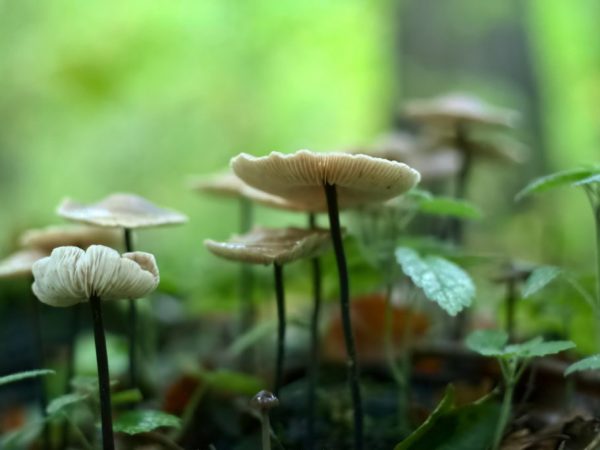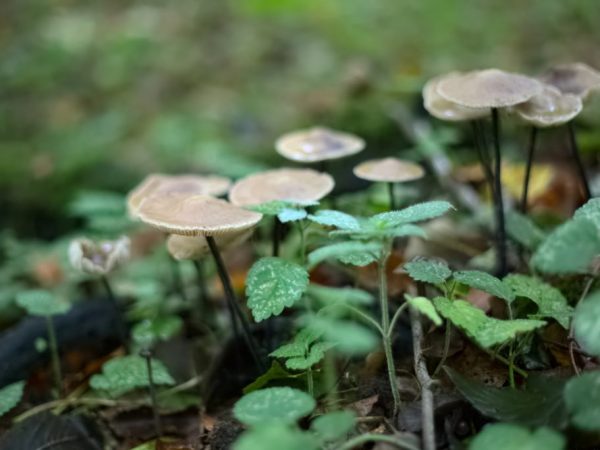Common garlic mushroom
The garlic mushroom is a member of the Garlic genus from the Negnium family of the Agaric order. It has a characteristic strong smell of the seasoning of the same name, therefore it is used in cooking when preparing spicy and spicy dishes.

Common garlic mushroom
Botanical characteristic
According to the description, the fruiting body of the garlic fungus has a colibioid (i.e., similar to the fruiting body of the colibia) captype type. The mushroom cap reaches from 0.5 cm to 2.5 cm in diameter in an adult specimen. The surface is hygrophilous: it can swell when exposed to water. Smooth, not translucent, sometimes grooved.
Initially, in young specimens, the mushroom cap has a conical convex or hemispherical appearance, the edges are tucked up. Over time, it acquires a flattened shape, the edges straighten and become wavy, and a depression forms in the center.
The color of the common garlic is different, depending on the weather:
- in wet weather: mushroom caps are light brown with a pink tint or red with ocher;
- during dry periods: the cap surface becomes less contrasting, cream or ocher color.
The center of the mushroom cap is usually darker than the edges.
The mushroom pulp is very thin, the color scale is similar to the surface of the mushroom cap. Has a strong garlic smell and taste.
The hymenophore plates are sparsely planted, numbering 13-20 pcs., Sometimes intertwining or with branches, practically free from the mushroom stem (do not attach to it). The color is close to white or with a yellowish or reddish tint. Spore powder is white.
The garlic plant has a second name - the common non-nut plant.
The mushroom leg is hollow in structure, 0.5-5 cm long, 1-2 mm thick. Naked, without covering, only slightly pubescent in the lower part at the base, shiny, has the shape of an elongated cylinder, located in the center, sometimes with longitudinal grooves. The color of the upper part of the mushroom leg is orange, closer to the base it turns into red-brown, in fact, even close to black.
Growing geography

Mushrooms grow in large groups
The growing areas of the common garlic fungus cover dry clay areas, sandstones in deciduous, mixed and coniferous forests. Preferred places of settlement are foliage and needles, hemp, rotting tree bark, branches, heather stems, in rare cases, fungi appear in the grass mass.
The active growth of garlic non-nippers occurs in the middle of the summer period and lasts until the beginning of October.
They grow in large groups. They are easy to spot in humid weather: it is then that the characteristic mushroom garlic smell increases its concentration over the places of their growth.
The main habitats are located in the Northern Hemisphere.
Similar varieties
The common garlic mushroom has varieties similar in description:
- Large garlic: it differs from the ordinary one in its large size (the cap reaches 5 cm in diameter), a black mushroom leg covered with a "hair" cover, as well as plates with uneven edges. Found in Europe among deciduous forests on fallen branches and foliage of beech trees.
- Garlic oak: this mushroom is a rare species. Most often he settles on fallen oak leaves. The variety is distinguished by a leg covered with red-brown hairs, an overly hygrophilous mushroom cap, in which the plates are strongly translucent in damp weather. The nearby substrate is able to give this species a white-yellow color and a specific garlic smell.
The garlic mushroom also has features similar in external description to meadow mushrooms, since it is found in similar places of growth and is also colored in shades of brown. The latter have no garlic smell.
Irina Selyutina (Biologist):
The song, which was invented by mushroom pickers, says that "the edible mushroom has a film ring on its leg." This is partly true. But it has nothing to do with non-mushroom pickers (ordinary, large, oak), which some novice mushroom pickers may confuse with meadow mushrooms. It is good that the non-nippers (garlic plants) belong to the edible species. But you still need to distinguish them:
- Garlic plants appear in late summer and autumn on dry litter in various forests.
- The sizes of the caps are small (maximum 5 cm in diameter).
- The color of the caps varies from almost white to brownish.
- In adult specimens, the caps are almost always very open and slightly inverted.
- Legs are very thin, dark colored, hard.
- On the legs, there are no scales and "skirts" characteristic of honey agaric.
- The plates of the hymenophore are wavy, sparsely located, usually white or cream-colored.
When picking mushrooms, it is important to take into account all the signs together, otherwise the pale toadstool may get into the basket.
Practical use
Garlic species are among the edible mushrooms. Before use in cooking, they do not require heat treatment. Suitable as a seasoning for marinades, sauces, main courses and soups. They are consumed fresh, dried, fried.
Common garlic is a valuable raw material, on the basis of which prophylactic and medicinal agents of bactericidal and antiviral spectrum of action are obtained. The chemical composition of the fungus contains antibiotic substances that can even fight staphylococcal infection.
Since the mushroom does not rot, it contributes to the preservation of individual food components and even increases its shelf life.
Conclusion
The common garlic mushroom is edible. It has a specific gastronomic purpose, thanks to the characteristic smell and taste of the seasoning of the same name. It is widely used in the culinary business. Grows in woodlands, starting in the second half of summer.



